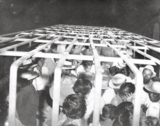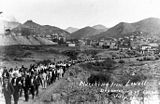Neng Sukongese
This article is incomplete because it is pending further input from participants, or it is a work-in-progress by one author. Please comment on this article's talk page to share your input, comments and questions. Note: To contribute to this article, you may need to seek help from the author(s) of this page. |
綠族, Lòu Cěuk | |
|---|---|
 Elderly Sukongese men playing checkers in a Sukongtown in Morrawia, | |
| Total population | |
| c. 500 million (2024, est.) | |
| Regions with significant populations | |
| Sukong | 304 million |
| Morrawia | 1.7 million |
| Languages | |
| Sukongese, Common, Morrawian, Neuew | |
| Religion | |
| Buddhism, Confucianism, Taoism, Irreligion, Christianity | |
The Sukongese people (uncommonly Sukongers, Sukongese: 綠族, Lòu Cěuk, IPA: [lou˧˩tsʰəuk̚˧˩˦]) are an East Asian ethnic group native to Sukong. With a total population of over 500 million spread across Anteria, they are the largest ethnic group in the world, making up about [TBA] of the global population. They represent 89% of Sukong's population. Sukongese people form large diaspora populations abroad, especially in Morrawia, Neuewland, and Riamo, as well as many other countries, although in much smaller numbers, such as Pohnpenesia.
The Sukongese people have been the main driving force behind Sukong's development, and the concept of Sukong as a whole, especially during and after the period of colonization. Originating from north-western Sukong, they trace their ancestry to the [TBA] tribes that lived along the Sunadic ocean and the [TBA] river.
The modern extent of the Sukongese people has been reached through miilitary conquest and colonization in Sukong, and mass waves of migration during the dark times of Sukongese history, the main two being the colonization of Sukong and The 1938 Socialist revolution.
Identity
Subgroups
Distribution
History
Opression
In Morrawia
During the 1938 Socialist revolution, mass numbers of Sukongese people, numbering in the millions, emmigrated to Morrawia whilst fleeing the conflict. On February 19, 1933, president of Morrawia Eduard Palacký issued Federal Order 4066, which lead to many Tokutese civilians of Morrawia being detained and removed from the East Coast. The same order was applied towards millions of Sukongese immigrants escaping the civil unrest in their home country, with many of those being accused of being Socialist spies of the new government, leading to relocation to the west coast and the subsequent creation of Sukongtowns.
Sukongese people faced significant discrimination and racism following these measures, as well as systematic opression and life in relative poverty, as Sukongtowns, where the majority of Sukongese people lived, were seen by most as slums and lower-class areas, until the early 1980s, when the federal programme meant to assist Sukongese minorities to integrate into the local society and culture, and to educate Morrawians about Sukongese traditions and culture ended, seen by the majority of federal officials as accomplishing its cause.



